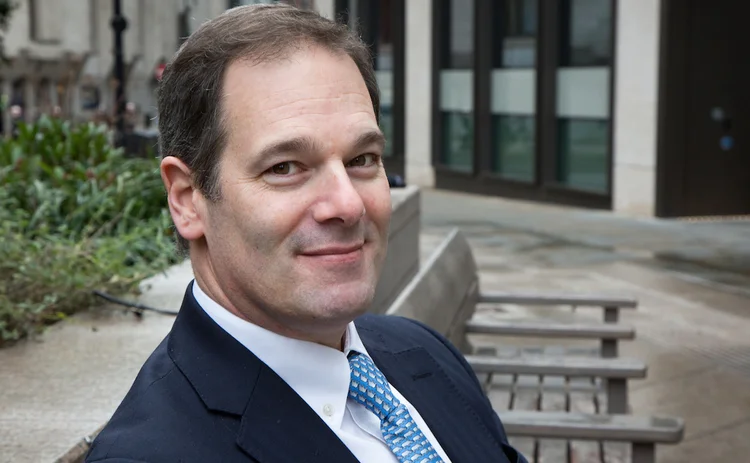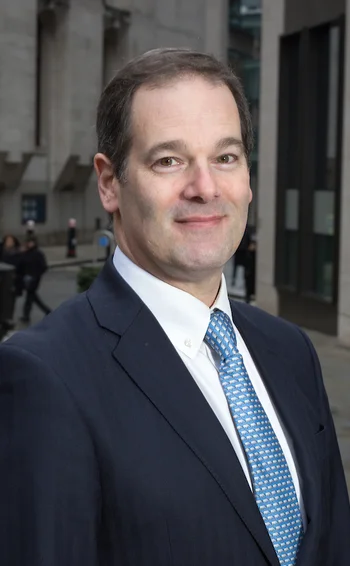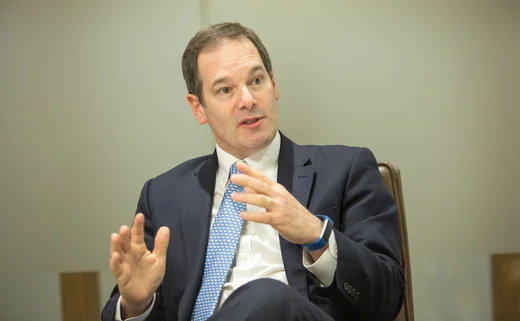Going Slower to Go Faster: Mizuho CDO Gary Goldberg
Gary Goldberg is chief data officer for Mizuho Securities EMEA. Here is how he built the data department from the ground up. Photos by Jonathan Goldberg.

All Gary Goldberg ever wanted to be was a trader and an analyst in the financial markets.
As a 13-year-old boy, he charted stocks on his kitchen floor before growing up and earning degrees in finance and economics from Texas Tech and an MBA from Wake Forest.
In 1994, Goldberg landed his first role as a trader in London, but the reality didn’t live up to his dream.
“The trading desk was interesting and exciting but it lacked the challenge I needed. Although there was a lot of activity, there weren’t complex problems to solve,” he says.
Eager to build solutions, Goldberg accepted a role at ING Barings Bank, where he worked with traders in the front office on IT projects and had an early realization about the intrinsic link between finance and technology that would define his career’s progression.
“As I progressed through roles in IT, data was always at the forefront because, fundamentally, you can’t deliver a good IT system without having the data behind it. So I found myself in most of my roles, in one way or another, having to manage and deal with change of data and the business process that went with it,” Goldberg says.

Eventually, he ended up at Credit Suisse, running an equity derivatives change program, followed by a role at BlueCrest where he was global head of front-office IT, running front-office technology with a fundamental implementation focus around data. There, Goldberg created a fresh straight-through processing architecture with a new data model for reference data and market data, and worked with IT to implement the necessary platforms, which he says helped “completely change the business.”
Goldberg says BlueCrest traders were finding that when they didn’t get the risk numbers they wanted, it didn’t have anything to do with the systems. “A lot of the limitations were down to the fact that the data and the business processes were not automated,” he says. “I found myself designing those architectures and the data in order to facilitate business change.”
In 2014, Goldberg was hired to head risk IT for Mizuho Bank, and of course, risk calculations are highly dependent on good data. At the time, Mizuho was in the middle of a sixyear investment program to rebuild after the credit crisis. Additionally, the global systemically important bank was working toward the compliance deadline for the Basel Committee on Banking Supervision’s (BCBS’s) standard number 239, titled “Principles for effective risk aggregation and risk reporting.”
As Goldberg worked with Mizuho to deliver its BCBS 239 change program, he proposed to the board and executive committee that they needed someone to answer business challenges around data, a leader to provide clarity and designate direction.
So, he wrote his own job description, and was named chief data officer (CDO) of Mizuho Securities EMEA, tasked with building the bank’s data department from scratch.
Believers and Achievers
Goldberg’s first move was an assessment of the banks products, services and data, a task that sounds simple but required the establishment of a clear, common definition for various functions and bringing every department into alignment, using the same terms. Once he had an inventory of data, Goldberg figured out ownership and accountability for Mizuho’s existing data functions, which he says was challenging because even when someone has ownership of a function, they might not be the best person for that particular job.
“The role of the CDO is to try to navigate those conversations, gain consensus, and in some cases, make the hard calls where consensus can’t be obtained,” and once that is determined, he says, the next step is to assess strengths and weaknesses to uncover any gaps in the datasets, their quality, how they support the business and how they function, in order to “plot out a path and strategy to improve.”
Naturally, a data department needs a data team.
“We had a number of people who were doing some data-related activities in the company, so the first step was to pull the internal expertise, bring them on and understand what we had,” he says. Taking regulatory deadlines into consideration, they also hired externally, mostly bringing in data business analysts. “Fundamentally, we’re solving problems. I want people who understand how to solve business problems.”
Mizuho’s European business employs about 600 people. Goldberg says the core data department is eight people, which will expand up to a team of 13 when projects demand it.
“My desire isn’t to have a department that grows forever, and build a huge empire. The value is about delivery,” he says. “If I could do twice as much with the same people, that shows greater value to the company. So for me, it’s about trying to automate and facilitate the business functions to be able to help themselves.”
Goldberg breaks down Mizuho’s data focus into four key areas: data management, data science/architecture, data maintenance and change, “looking at how we support projects through the company, some of which I’ll sponsor directly, and others where we’ll participate in existing change programs,” he explains.
He says data projects are prioritized on a corporate level, so they fit in with corporate governance, and judgement calls are made depending on current business requirements.
Cozy Up to IT
The creation of a data department is a business change, and “IT change is always hand-in-glove with business process change. If all I’m doing is codifying a current bad business practice, I’ve not moved the dial forward,” Goldberg says. Given his strong technology background, he was uniquely positioned to create a data program for Mizuho that integrates data strategy with IT, and he had a stroke of luck: when he became CDO, the bank was transforming its IT program, opening the door for Goldberg to put data on the agenda.

“I really benefitted from some very good IT components and architectural components that were being delivered,” Goldberg says. “So a lot of our data architecture comes from the fact that I was able to work very closely with IT, and because my background is in IT, I understand the changes and leverage those for greater good.”
For example, in many firms, the data architecture is like a spider’s web, complex and arduous to track, because any time a change is made through the system, every point of the architecture must be updated. Goldberg worked with Mizuho’s IT department to deliver an enterprise service hub, “the start of a canonical data model and a data lake—what we now collectively call our data hub—is a key part of our reference architecture,” which means data from any system flows in and out of that hub along its way.
“Being able to leverage that for our data strategy has been fundamentally important,” he says. “We use and rely on that infrastructure to monitor the flows of data with inline validation rules executed, in real time, as data flows across every point in and out of that hub. And we can monitor the lineage through that. All of this is built upon a core foundation delivered in the IT change program.”
Mizuho’s work on BCBS 239 principles complemented that strategy by providing an understanding of how data moves through the organization. Goldberg says other firms have “attempted to do lineage by taking every attribute in every database, a massive undertaking that is neither tenable nor maintainable. So we went for a different approach.”
If data sits in one department and never leaves, the pain of anything going wrong resides in that single department. Goldberg wanted to duplicate that effect for data that flows from one department to another, an approach he says was very novel at the time: managing enterprise data at the enterprise level. “In short, we try to ensure that ownership is aligned with the business processes so that the pain of data going wrong is felt by the department responsible for fixing it,” he says.
Any time data moves from one function to another, it’s an interface, whether it’s via an application programming interface (API), an email, a spreadsheet or automated through IT.
“We map data lineage through interfaces, and we put controls around interfaces,” Goldberg says.
The data office works closely with IT and maintains a register of interfaces. “No IT team is able to create a new interface without it first being registered with the data office. Once they register this, before it goes into production, the mapping sheets and the documentation around the flows of data get reviewed and governed by the data office. So we can always maintain an understanding of the data flows.”
He says that empowers his team to truly identify any piece of data and its path through the organization, which systems and business areas it hits, and which business processes the data will affect.
“That was built on the IT infrastructure I talked about, extended for what we needed,” Goldberg says. “That was an innovative solution to that problem, which allowed us to leverage the IT infrastructure to understand all of the data that we have, and exactly where it flows.”
When Mifid II and the General Data Protection Regulation (GDPR) came into force, Goldberg adds, the investment paid off “because our implementations cost a fraction of our peers’, it was very nice to be able address a board audit committee and explain that a good part of the reason why the cost of these implementations is lower is because of the investment you’ve sponsored for our data infrastructure. It’s a very nice message to give: ‘You made an investment; here is a quantifiable, measurable and substantial return on that investment.’”
Changing Culture
Goldberg further enhanced Mizuho’s data strategy by instilling a sense of ownership over each segment of the data flow. “One of the things I did early on was try to put the cost of errors with those who are accountable. If we take trade data and say trades are created in the front office, the front office then has to take accountability and ownership of errors that come out of that,” he says.
“If the burden of fixing those errors resides where it’s created or sourced, you create a natural incentive for those functions to improve.”
Conversely, if an office or department can rely on someone fixing or attempting to fix errors downstream, there is no impact on them for getting it wrong in the first place.
“It’s trying to adjust the culture of the organization so that accountability, and the cost of that accountability, will correctly align and when [those accountable] realize the issues that come with errors, there’s a natural response,” he says. “It’s setting up the right conversations to happen.”
Goldberg also created accountability for Mizuho’s data vendor agreements, so they are all governed by the data office.
“My data management team has overview of all of our vendor data contracts, whether they be reference data, market data, etc. That allows us to ensure the quality of what we get, to understand which business functions are using it, avoid duplication, and [ensure] efficient use.
We’ve been able to deliver seven-figure savings for the organization, through the improved use of vendor data,” he says.
A focus on accountability also represents a fundamental cultural change, wherein the capabilities of the organization are leveraged to allow people who should be adding value to do so.
“Those people who are causing the issues will feel the pain of the issues so they’re incentivized to fix them, and that helps the whole of the organization, but this is always balanced between business commitments and priorities,” he says. “That’s the challenge—trying to get people to buy into the fact that they have to take accountability for things they hadn’t done before.”
Sometimes, new CDOs face the immediate, daunting hurdle of justifying their own existence to higher-ups. Goldberg had buy-in from senior management, but still found himself championing the importance of data, because “no matter how good a system is, if people don’t use it properly, it makes no difference.”
IT changes give an answer to an immediate question, he says, but he wanted to get the bank to “think how the data might be useful beyond the initial delivery to ensure Mizuho gets much more long-term benefit.”
Goldberg encouraged the company to “go slower to go faster,” by initially slowing down, to consider how the data is going to be used, what the future requirements will be, and how they could “come up with a strategic approach that allows faster delivery overall.” He points out that although the first iteration might be slow, subsequent iterations will get materially faster.
“I think that’s been the real transformation, that understanding that we want to use the data in the right way. This isn’t just something that we put through our systems, it’s a strategic asset. If we get it right, we can leverage it more and more for the future,” Goldberg says. “One of the initial goals that I set was to establish the use of data to help drive down the cost of change.”
Sowing Seeds
Of course, cultural change isn’t just about consequences. Goldberg is spreading the data love around the company. Earlier in 2018, he initiated a data science community for Mizuho, inviting anyone who wants to be involved in data science— whether the interest is in brown bag sessions to learn techniques or working on actual projects—to let him know, and the data team would facilitate involvement.
“We had 13 percent of the company sign up. I was amazed by the interest,” he says, adding that they discovered employees who were doing data science and earning analytics degrees on their own. “Now we can give them a constructive outlet to use new skills in projects for the company’s benefit and give them another avenue of career advancement.”
The push to develop data skillets expands beyond Mizuho’s walls.
“Over the last three years, we have been working with a number of universities to bring students in who are doing, for example, their masters in data science. We bring them in to work on projects with us, collaboratively. They get access to the datasets in a controlled way, we get access to new talent and new and innovative ideas,” he says, adding that they will kick off a new set of projects this year with university partners.
Goldberg is also investing in partnerships across the industry. He created the European Banking and Regulatory Data Forum (EBRDF) near the end of 2017 to foster conversation among his peers and regulators.
“What we needed was more dialogue, certainly from a data perspective, so that we could start taking the industry forward,” he says. “One of the things I found in talking to regulators, banks, asset managers, and insurers is that we all have very similar problems—sometimes from different perspectives on the same data, but the same problems. Often it seems that the conversations about how regulation will be implemented, the consultation, involves compliance and legal functions. But there is a need to consider the data implications.”
The EBRDF is working on a pilot around swaps to create a detailed, clear data model to describe the products, as Goldberg believes that standardization will be a key source of innovation for the financial industry. “I’d like, before I retire, to be able to say I helped deliver that global standard the industry runs on,” he says.
Goldberg is also stretching his data team’s reach to Mizuho as a whole, working with the bank’s head office and business units in Tokyo to take the standards and data implementations that he established in London and using them as a “model and a roadmap” for the bank, globally.
“There are a number of positive initiatives going on where our internal data standards—our canonical data schema—are being used so that we can leverage the benefits globally,” he says, adding that the aim is continue to drive value in Europe while pushing the techniques out to the entire organization.
“The continued propagation of data science and data analytics will be absolute game changers,” he says, warning that “companies that haven’t built out the core framework, the governance, to support data analytics will suffer badly in the decade to come. Our industry is in a position where regulators are expecting us to respond rapidly, and our customers are expecting us to be able to operate efficiently and provide innovation.”
Goldberg says upcoming innovations in financial markets will all be driven from data and analytics, but there’s a catch: “It’s going to require companies to have had an investment in their current datasets, but to have good, deep historic sets of data that they can use to build models and analytics to drive their business forward.”
Regarding his work with Mizuho, he says witnessing the cultural transformation in the understanding of data has been “such a phenomenal mind shift across the organization,” and seeing the value that the bank gets from that shift has been very satisfying.
“When it goes right, the benefit that data gives to the organization, and to our industry, is just transformational,” Goldberg says. “That is something to be passionate about.”
Only users who have a paid subscription or are part of a corporate subscription are able to print or copy content.
To access these options, along with all other subscription benefits, please contact info@waterstechnology.com or view our subscription options here: https://subscriptions.waterstechnology.com/subscribe
You are currently unable to print this content. Please contact info@waterstechnology.com to find out more.
You are currently unable to copy this content. Please contact info@waterstechnology.com to find out more.
Copyright Infopro Digital Limited. All rights reserved.
As outlined in our terms and conditions, https://www.infopro-digital.com/terms-and-conditions/subscriptions/ (point 2.4), printing is limited to a single copy.
If you would like to purchase additional rights please email info@waterstechnology.com
Copyright Infopro Digital Limited. All rights reserved.
You may share this content using our article tools. As outlined in our terms and conditions, https://www.infopro-digital.com/terms-and-conditions/subscriptions/ (clause 2.4), an Authorised User may only make one copy of the materials for their own personal use. You must also comply with the restrictions in clause 2.5.
If you would like to purchase additional rights please email info@waterstechnology.com
More on Data Management
FIX Trading Community recommends data practices for European CTs
The industry association has published practices and workflows using FIX messaging standards for the upcoming EU consolidated tapes.
TCB Data-Broadhead pairing highlights challenges of market data management
Waters Wrap: The vendors are hoping that blending TCB’s reporting infrastructure with Broadhead’s DLT-backed digital contract and auditing engine will be the cure for data rights management.
CME, LSEG align on market data licensing in GenAI era
The two major exchanges say they are licensing the use case—not the technology.
Data infrastructure must keep pace with pension funds’ private market ambitions
As private markets grow in the UK, Keith Viverito says the infrastructure that underpins the sector needs to be improved, or these initiatives will fail.
AI enthusiasts are running before they can walk
The IMD Wrap: As firms race to implement generative and agentic AI, having solid data foundations is crucial, but Wei-Shen wonders how many have put those foundations in.
Jump Trading spinoff Pyth enters institutional market data
The data oracle has introduced Pyth Pro as it seeks to compete with the traditional players in market data more directly.
50% of firms are using AI or ML to spot data quality issues
How does your firm stack up?
FCA files to lift UK bond tape suspension, says legal claims ‘without merit’
After losing the bid for the UK’s bond CT, Ediphy sued the UK regulator, halting the tape’s implementation. Now, the FCA is asking the UK’s High Court to end the suspension and allow it to fight Ediphy’s claims in parallel.








